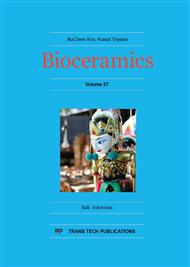p.45
p.51
p.57
p.60
p.69
p.74
p.80
p.85
p.89
Adhesion Properties of an Apatite Film Deposited on Dentine Using Er:YAG Laser Ablation Method
Abstract:
Tooth enamel cannot be naturally reconstructed once it is destroyed immoderately. Therefore, the restoration of enamel is important in dental treatment. Hydroxyapatite (HAp) can potentially be used for a novel dental biomaterial to repair the enamel. We have proposed a tooth restoration technique with intraoral laser ablation method. A thin layer of HAp was deposited on dentin surface in the atmosphere by ablation phenomenon using an Er:YAG (Erbium: Yttrium-Aluminum-Garnet) laser irradiated to the target of α-tricalcium phosphate (α-TCP). Then, the deposited layer was hydrolyzed by dripping pure water on its surface in order to create HAp film. The adhesive strength between the HAp film and dentin was evaluated by quasi-static tensile tests. As a result of the mechanical evaluation, the adhesive strength was greater than approximately 3.8 MPa. It is clear that the HAp film created by the Er:YAG laser ablation method is attached tightly to the dentin.
Info:
Periodical:
Pages:
69-73
Citation:
Online since:
May 2016
Price:
Сopyright:
© 2016 Trans Tech Publications Ltd. All Rights Reserved
Share:
Citation:


